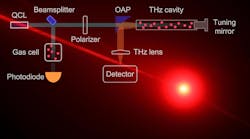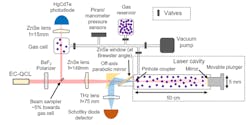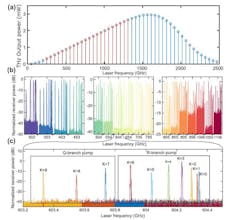What you’ll learn:
- How lasers are used as terahertz frequency sources.
- The impact of the transition from nitrous oxide to methyl fluoride as the lasing gas.
- Results achieved by the researchers.
Interest in the terahertz band—likely the next region for wireless spectrum opportunity as well as specialized sensing—continues, with significant research at the university level. However, despite decades of research, no frequency tunable sources span the terahertz gap between 0.3 to 3 THz.
But there’s genuine progress: A team at the Harvard John A. Paulson School of Engineering and Applied Sciences (SEAS), working in collaboration with the DEVCOM Army Research Lab and DRS Daylight Solutions, demonstrated continuous-wave lasing with more than 120 discrete transitions spanning the range from 0.25 to 1.3 THz. The work builds on the team’s previous prototype that proved terahertz frequency sources could be compact, room temperature, and widely tunable by combing a quantum cascade laser pump with a nitrous oxide (laughing gas) molecular laser.1
However, this new research more than triples the tuning range of that prototype. Among its many advances, the laser replaces nitrous oxide with methyl fluoride (CH3F), a molecule that reacts strongly with optical fields.
This laser already has the potential to be one of the most compact terahertz lasers ever designed—and the researchers aim to make it even more compact. “A less-than-a-cubic-foot device will enable us to target this frequency range for even more applications in short-range communications, short-range radar, biomedicine, and imaging,” said Paul Chevalier, a research associate at SEAS and lead researcher of the team.
“This compound [methyl fluoride] is really good at absorbing infrared and emitting terahertz,” explained Arman Amirzhan, a graduate student at SEAS and first author of the paper. “By using methyl fluoride, which is non-toxic, we increased the efficiency and tuning range of laser.”
How Does It Work?
The molecular interaction, quantum-level physics, and associated analysis are daunting and intense, and fully explained in the published paper; the hardware itself is complicated as well (Fig. 1). The THz cavity is a 50-cm copper pipe with a 4.8-mm internal diameter. A flat mirror with a centered 1-mm-diameter pinhole was used as the output coupler. The cavity resonance frequency was tuned by changing the tuning mirror position to adjust the cavity length.
In operation, the pressure in the laser cell is controlled by cryogenic pumping, beginning with evacuation of the cell to a very high vacuum (below 10-5 mTorr). Gas-phase methyl fluoride is contained in a small 10-mL metallic cylinder connected to the system with a needle valve. This cylinder is cooled down by liquid nitrogen, which causes the gas to solidify.
After this initial cool-down period, the valve to the vacuum pump is closed and the valve of the cylinder is opened. The liquid nitrogen is then removed and the cylinder is allowed to warm, which causes the solid methyl fluoride to sublime, changing directly into vapor without an intermediate liquid phase, and fill the rest of the system. The valve of the cylinder is closed when the proper pressure is achieved.
To achieve laser emission, the laser cavity is first filled with CH3F at the desired pressure. Then the quantum cascade laser (QCL) is tuned to a desired gas absorption line by setting the correct drive current, grating position, and laser temperature in the QCL controller. Though complicated, the result is dramatic.
Evaluation and Performance
It’s one thing to establish this sort of terahertz source, but it’s another to assess its performance. The emission frequencies were measured with one of several heterodyne mixers and detectors depending on the place in frequency band.
Schottky diode detectors were used between 0.25 and 1.1 THz, a Golay cell was used above 1.1 THz (a Golay cell is a type of opto-acoustic detector mainly used for infrared spectroscopy2) and heterodyne receivers were used to measure spectra between 0.3 and 1.1 THz (Fig. 2). The local oscillator is provided by a tunable frequency generator while the intermediate frequency is measured on a spectrum analyzer (all test equipment vendors and specific units are identified in their paper).
The laser linewidth can be measured experimentally, using the same heterodyne receiver that was used to recover each line frequency. In practice the linewidth stability seemed limited by the mechanical stability of the cavity. The smallest measured linewidth was recovered for one of the lowest frequency lasing lines measured, at around 402.9 GHz, with a recovered line width less than 1 kHz (Fig. 3).
Many variables are responsible for basic performance and efficiency. The output power of the terahertz laser emission depends on a combination of multiple factors, including the choice of the gain medium, the IR pumping efficiency, and the laser cavity design. The choice of the gain medium is motivated by a range of factors, too, including its IR absorption coefficient and saturation.
The performance of the laser cavity is determined by its geometry, cavity quality factor, loss factor of pump power inside the cavity, and the terahertz losses in the output coupler. The optimal cavity dimensions, operating pressure, and more accurate output powers are calculated by performing extensive molecular dynamics simulations.
The work is detailed in their seven-page paper “A quantum cascade laser-pumped molecular laser tunable over 1 THz” published in APL Photonics, along with a 16-page Supplementary Material file.
References
1. Electronic Design, “Strange EM Sources: Laughing Gas for THz Waves, Peeling Tape for X-Rays”
2. Wikipedia, “Golay Cell”



